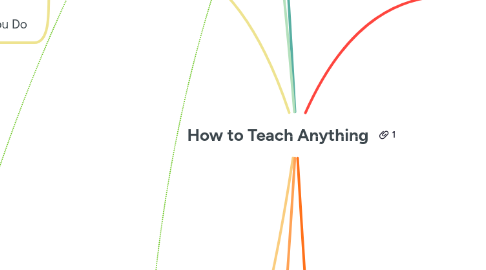
1. Pedogical Approaches to Teaching
1.1. Constructivist Approach
1.1.1. Build complex concepts from smaller simpler ones
1.2. Inegrative Approach
1.2.1. How knowledge is applied to real world (what it means to me)
1.3. Collaborative Approach
1.3.1. group/ teamwork to share process of learning
1.4. Inquiry-Based /approch
1.4.1. Using, questions, answers, and methods or a combination of the three
1.5. Reflective approach
1.5.1. Teacher stops and appraises techniques and effectiveness and adjustsacordingly
2. Learning Theories
2.1. Cognitive Load Theory
2.1.1. Brain can only do one thing at a time (working memory)
2.1.1.1. About 20 seconds
2.1.2. Learning something more cognitive load than retrieving from LTM
2.1.2.1. Break things down into chunks or work with summaries
2.1.2.1.1. Reduces strain on cognitive load
2.1.2.1.2. consider begining, then nexts teps
2.1.2.1.3. Use plenty of examples
2.1.2.1.4. Every 10-15 minutes switch activites
2.1.2.2. Does students have enough stored knowledge to draw on? Are you presenting too many things at once? How are you pacing info? Is this overwhelming or gently challenging your students?
2.1.2.3. Split lessons into 15 minute chunks
2.1.2.3.1. Opportunities to create simple mind map that summarizes the points learnt
2.1.3. Information Processing Model
3. Scaffolding
3.1. Goal: Simplify
3.1.1. Explain/ Instruct
3.1.2. Demonstrate
3.1.3. Modeling
3.1.4. Insruct: Tell them what to do exactly
3.1.5. Feedback/ Correction
3.1.6. Restructure Task (Mini Tasks)
3.2. I Do/ We Do/ You Do
3.2.1. I DO
3.2.1.1. Learning Targets
3.2.1.2. Success Criteria
3.2.1.3. Background Knowledge
3.2.2. We Do
3.2.2.1. Intruction is guiding action
3.2.2.2. Opportunities to practice new skills
3.2.2.3. uses Questions and Prompts
3.2.3. You Do
3.2.3.1. Perform the skill or retrieve info on own
4. Creating a Concept Map
4.1. Connects multiple ideas/ concepts concepts and the relationship between them
4.2. Have you broken down new info into manageable small chunks?
4.3. Have you shown connections between chunks?
4.4. Are you being as clear and simple as possible?
4.5. Does the map go somewhere secific? do you have an end point in mind?
4.6. Can you see how each sub unit relates to t end point?
4.7. Are there any gaps in the plan? Have you made any assumptions about what students know?
4.8. Have you included what students already knows and are you drawing links between that and what they dont't understand yet?
5. Advanced Techniques
5.1. Problem Based Learning
5.1.1. 1. Define your Problem
5.1.2. 2. Determine what you already know
5.1.3. 3. List potential solutions and choose the one most likely to succeed
5.1.4. 4. Break the steps into action items (in a timeline might help)
5.1.5. 5. Identify what you still need to know and how you will get that info
5.2. Effective visuals
5.2.1. Mind maps
5.2.2. Ven diagrams
5.2.3. Flow charts
5.2.4. Story boards
6. Seeing the Landscape
6.1. Creating a Road Map
6.1.1. knowing what to ignore thats irrelevant
6.1.2. Simplified but accurate
6.2. Study Techniques
6.2.1. Practice Teaching new material
6.2.1.1. Mind Maps
6.2.1.1.1. linking what you learn now with what you already learnt
6.2.1.1.2. Linking new connections to separate info
6.2.1.1.3. Sketch out Mind Map of struggling info
6.2.1.2. The Feynman Technique
6.2.1.2.1. Step 1: Choose your concept
6.2.1.2.2. Step 2: Write down an explanation of the concept in plain English
6.2.1.2.3. Step 3: Find your blind spots
6.2.1.2.4. Step 4: Use an analogy
6.2.2. Blooms Taxonomy of Learning (1956)
6.2.2.1. Remember
6.2.2.1.1. Verbs: Listening, Finding (i.e. googling), actively memorizing data, bookmarking, highlighting key points, and repating (repition) info
6.2.2.1.2. Outline key features/ quotes/ defining main ideas
6.2.2.2. Understand
6.2.2.2.1. Verbs: Categorizing data, grouping info, inferring from data, predicting based on data, summarizing, and paraphrasing
6.2.2.2.2. Engage with info more activley/ picking it apart to see how to works
6.2.2.3. Apply
6.2.2.3.1. Verbs: Executing, sketching, acting out, articulating, charting, presenting, painting, preparing, displaying, reanacting, or playing
6.2.2.3.2. i.e. making pie charts, turn plan into reality, or design experiements
6.2.2.4. analyze
6.2.2.4.1. Verbs: Questioning, explaining, organizing, deconstructing, coorelating, and calculating
6.2.2.4.2. i.e. drawing mind maps, breaking down into parts, "Why is this happening?"
6.2.2.5. Evaluate
6.2.2.5.1. Verbs: Criticizing, rating, reflecting, reviweing, assessing, and validating
6.2.2.6. Create
6.2.2.6.1. Verb:Composing, mixing, folming, writing, role -playing, programing, designing, adapting, podacastiing, bloging, leading
6.2.3. Spaced Repetition
6.2.3.1. Space out your rehearsal (studying) over long periods of time 1-2 weeks if possible
6.2.3.2. Sleep is where neural connections are make
6.2.3.3. While studying, recall as much as you can, without looking at notes better way of processing info
6.2.3.4. Go back through what you missed, make notes of what you need to pay closer attention to
6.2.3.5. Give your brain time to move info from STM to LTM
6.2.4. cornell notes
6.2.4.1. makes your notes easier to read and study main points
6.2.5. Purposeful annotation
6.2.5.1. Before you read: set goals/ intentions
6.2.5.2. During reading: Make meaningful notes and annotations
6.2.5.3. After reading: perform task to cement and apply what they've read
7. Making the most of analogies
7.1. Use multiple analogies for same topic
7.1.1. Antonyms
7.1.1.1. if hot is opposite of cold, what is the antonym for ________?
7.1.2. Example/ type
7.1.2.1. _______ is a type of _________ like IPhones are a type of smartphones.
7.1.3. Thing/ characteristic
7.1.3.1. What is a characteristic of _______ similar to the volume as a characteristic of speakers?
7.2. Use examples to constantly reaffirm learning
7.2.1. Make dry content more realistic and relevant to the world around you
7.3. Remember the purpose of the analogy
7.3.1. Not enough to remember the analogy, you must know why its an appropriate example of one
7.3.1.1. 1. find exisiting, familiar piece of info
7.3.1.2. 2. How do they Differ?
